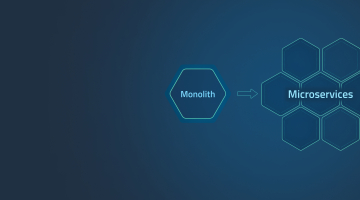
Essentials of migration from monolith to microservices architecture
Having been introduced at the dawn of the computer age, monolithic system architecture was the staple of software development. Yet, what worked perfectly in the middle of the 20th century proves outdated nowadays. A dozen years ago, IT specialists came up with a microservices approach to back-end elements’ organization as a viable alternative to the classic monolith – and it disrupted the high-tech world.
Since then, organizations have started moving from monolith to microservices in their professional solutions steadily but surely, with 85% of enterprises (according to Statista) reporting the use of the newer architecture type in 2021. Evidently, these guys do know something to convert monolith to microservices en masse. If you still rely on old-school products in your shop floor operations, it is time to follow their suit and switch from monolith to microservices as a part of your digital transformation initiative.
But before we focus on the peculiarities of migrating monolith to microservices, let’s have a brief look at both software organization models.
Monolithic vs microservices architecture: Comparison
Monolith is a software development classic. This architecture contains a single-block unit with one code base and all functions served in one place. All the modules within it (typically, a database, a client-side UI, and a server-side component) are tightly coupled, which rules out any modifications to separate system elements. Although simple in development, deployment, and testing, monolithic solutions are notorious for their rigidity, code complexity, and incompatibility with novel technologies.
Microservices is all the monolith is not. The younger technology presents software architecture as a collection of separate modules that run each process as an independent service. Every unit has its own database, scope, and operational logic, and they are bound together via a network of APIs, which makes them similar to a combination of standalone software products. As a result, each containerized module can be independently built, deployed, revamped, and upgraded. Besides, such solutions are resistant to cascading faults and foolproof in bug detection.
What perks do software owners and users get by switching over from monolith to microservices?
Read a related article: Microservices vs monolith: Which architecture is better?
Advantages of monolith to microservices migration scrutinized
Companies that perform the transition from monolithic to microservices architecture of their enterprise digital infrastructure can enjoy the following boons.
- Business flexibility. The containerized nature of a microservice application or other solution allows for a quick and easy introduction of changes to the system. In the current highly aggressive business environment, it spells a significant competitive edge since you can add, remove, or upgrade certain features of the solution as your organization’s needs, marketing plans, or industry trends require.
- Scalability. You can scale any component of your solution up or down without affecting the functioning of other elements or the entire product. Such granular scalability lets you optimize resource consumption, reduce wastage, and avoid cost overhead.
- Resilience. As containers’ boundaries are hard to cross, the malfunction or code errors in a certain service can’t bring down the whole system. You can still use the fully functional modules while fixing the problems in the one where a failure is detected.
- Code transparency. The code base is simpler to understand and manage in smaller units with fewer dependencies. The IT personnel will have no problems in dealing with code if its modification is necessary.
- Easy testing and bug detection. Bugs and glitches can’t spread outside a module thanks to impenetrable container borders. That is why, once the QA team knows where to search for a problem, it will take them less time to get rid of it. Besides, troubleshooting and testing a microservices solution proceed quicker, with testers checking each unit piecemeal.
- Versatile tech stack. Unlike monoliths, which are limited to one programming language and technology across the system, microservices leave you free to choose any programming language, tool, or framework for each module to dovetail your technical and business goals.
- Freedom in selecting vendors. You can recruit different IT companies that excel in creating or replacing certain elements of a microservices solution, thus pooling the best-in-class talent to obtain a first-rate unit within the product.
- Greater productivity. Since each module is built, upscaled, tested, and deployed independently, and the coupling among units is loose, several development teams can work in parallel. If you split monolith into microservices, you will receive a finished product much faster, and its time to market will be minimal.
- Third-party integrations. Modern professional solutions seldom function as standalone products. They work in sync with other software – both internal (ERP, CRM, PIM, etc.) and external (social networks, various apps, payment systems, and more). By switching from monolithic to microservices architecture, your software gets access to such products due to a network of APIs, which boosts the efficiency of your IT infrastructure immensely.
- Embracing the cloud. Thanks to their cloud-native nature, microservices solutions can become a pivotal element of an enterprise’s cloud-first IT environment development strategy that will enhance the high-tech power of an organization.
- Expenditure optimization. One of the major monolithic to microservices challenges is the high cost of the procedure. But you can break monolith to microservices and then migrate module-by-module. This way, you don’t have to spend a huge sum on the transition simultaneously. Instead, you can move gradually and pay for the migration in installments.
As you see, the upsides of migrating from monolith to microservices are rather weighty. How should you go about it? As a seasoned IT vendor with multiple migration projects under our belt, DICEUS can share monolith to microservices best tips with you. The first step here is to opt for the proper migration strategy.
Choosing a monolithic to microservices migration strategy
There are five basic approaches to transition from monolith to microservices.
Incremental refactoring
This strategy involves the progressive decomposition of a monolith into microservices. Refactoring a monolith to microservices starts with pinpointing elements of the monolith (conventionally, some isolated capabilities) that are most suitable for becoming separate microservices. Then, you disable them and implement their transformation.
Strangler pattern
This approach gradually replaces monolith elements while the older architecture is not disrupted. Thus, the transition proceeds smoothly, and the company’s workflow continues.
Decomposing by business capability
Typically, the technical characteristics of your IT environment are aligned with the business objectives, so the monolith is broken into microservices depending on the business functionalities of the system’s components. Since one microservice will be responsible for one business capability, the complexity of the solution is kept to a minimum, whereas the independence of microservices is strong.
Anticorruption layer (ACL)
The main aim of ACL is to preserve the system’s business logic intact in the migration process. The mentioned layer functions as a barrier between the monolith and microservices, where data and requests are converted. ACL-based strategy is the safest one recommended when a legacy solution is migrated, and the documentation describing the business logic behind it is missing or deficient.
Domain-driven design (DDD)
Here, the strategy departs from understanding the business domain where the solution is employed. First, a business sector model is created, and then it is leveraged to design microservices that relate to a certain component of the industry niche. In this way, the newly developed architecture will fully support the company’s business objectives.
When you have decided upon the migration strategy that meets your requirements, you should devise a detailed roadmap.
A step-by-step monolithic to microservices migration plan
While implementing a switchover from monolith to microservices, our qualified experts in software architecture design stick to the following algorithm.
Step 1. Assessing readiness for migration
At the outset, you should get a clear-cut picture of the current infrastructure, the customer’s internal policies, and your team’s competence. It includes identifying business and technical objectives of the project (innovation, downtime minimization, scalability, etc.), sizing up the condition of the IT ecosystem, signing service level agreement, determining migration team composition, selecting tech stack, and taking care of security measures (firewalls, communication and network security protocols, authentication procedures, etc.).
Step 2. Pinpointing functions and dependencies
Since monolith code is often complex and confusing, you should ensure you have all legacy solution functions and business capabilities laid out fairly and squarely before you. After that, you will eliminate redundant applications and obtain a roster of features that will later become standalone microservices with their specific responsibilities and data repositories.
Step 3. Choosing and prioritizing migration candidates
Now, you should understand which functional groups must be moved to microservices first and which can stay in the monolith system for a while. Usually, the top candidates for transition are the mission-critical business capabilities that provide the maximum value as microservices. Also, they are the ones that are easier to migrate, the ease being conditioned by the fewest number of dependencies and susceptibility to decomposition into smaller components. As a rule, notifications, invoicing, and order management tick all these boxes.
Step 4. Selecting an infrastructure
Here, you should review the cloud providers whose pricing and resources suit your business and technical requirements. Conventionally, the choice lies between Google Cloud, Microsoft Azure, and Amazon Web Services (AWS). The benchmarks you should steer by are autoscaling opportunities and infrastructure maintenance services they offer.
Step 5. Separating the solution’s layers
This is the first preparatory move, consisting of separating the business logic, presentation, and data layers of your monolithic product. To do that, you must set up API gateways that create boundaries between the layers, handle cross-cutting tasks (authentication, SSL termination, rate-limiting, and the like), and route requests between the front and back end.
Step 6. Taking care of communications
In loosely coupled architecture, effective communication between services is crucial. To ensure its seamlessness, you should first opt for a messaging pattern, where asynchronous communication is preferable as it can send multiple messages simultaneously. Then, you set up server-side and client-side (or public) APIs, remembering that the former should be relevant regarding latency, payload size, and network performance, whereas the latter must be compatible with mobile and web apps you leverage. Typically, developers go for REST over HTTP/HTTPS for the client side and RCP plus RESTful interfaces for the server side.
Step 7. Moving the data
Now, you are ready to migrate legacy logic, databases, and behaviors supporting your product. Being vetted experts in data migration, we recommend configuring your APIs to retrieve information from other services as well since some apps will rely on old data from the monolith.
Step 8. Creating CI/CD pipeline
It is pivotal for obtaining top-notch architecture for your microservices solution. Why? Because continuous integration enables your team to maintain the high quality of the code by automatically testing changes introduced to it, while continuous delivery tools let you automatically transfer code changes to the production environment.
Step 9. Implementation and deployment
During the final stage, you should proceed carefully to make sure everything functions according to the expectations. Here, the canary release is a good technique to apply since it allows you to increase the user traffic progressively, keeping your eyes skinned for problems and malfunctions all the time. In case you face semantic difference issues between the old and the new system, you should leverage the anti-corruption layer (see above). After the transition is completed and the new product works smoothly, you can remove the ACL and retire the monolith elements.
You can see that converting monolith to microservices is an effortful and elaborate endeavor that must be entrusted to seasoned professionals in the field. Specialists of DICEUS possess the necessary experience and skills to handle monolith to microservices migration projects of any scope and complexity. Contact us to transform your IT environment into a robust and scalable system open to harnessing state-of-the-art technologies.
Summing it up
Being all the rage 50+ years ago, old-school monolithic solutions live on borrowed time today. Consisting of tightly coupled components that rely on a single code base, such products lack scalability, flexibility, code transparency, versatility of tech stack, and compatibility with novel technologies essential for meeting the demands of the 21st century.
By switching to microservices architecture, you will obtain robust and fault-resistant cloud-native software whose modules can be created, upgraded, tested, and deployed independently. The containerized nature of such solutions allows for their fast development, foolproof testing, and enormous upscaling opportunities.
To successfully implement the transition, you should opt for a suitable migration strategy, follow the conversion roadmap, and hire a high-profile IT vendor to perform this no-nonsense job.
FAQ
What is the significance of migrating from a monolith to microservices architecture?
Monolithic architecture is a legacy model of organizing software elements that fails to meet the imperatives of the time. Companies clinging to it are sure to lag behind their competitors who migrate to microservices after realizing the broad scalability and flexibility opportunities this novel architecture principle ushers for far-sighted IT-driven businesses.
What challenges are typically addressed by migrating from monolith to microservices?
Suppose you switch over from monolith solutions to microservices. In that case, you abandon a rigid and change-resistant product with a confused code hardly compatible with cutting-edge know-how in favor of a flexible solution that has a huge upscaling potential and can play well with multiple third-party systems and ground-breaking technologies.
What are the key benefits of migrating to microservices?
By embracing microservices, an organization obtains broad business flexibility, increases the scalability and fault-resilience of its IT infrastructure, streamlines its troubleshooting and bug detection, improves productivity, augments integration opportunities of its solutions, adopts a cloud-first approach in software ecosystem organization, and optimizes expenditures.
Can migration to microservices be done incrementally, or is it an all-or-nothing process?
It depends on the migration strategy software owners adopt. If they opt for incremental refactoring, the transition to microservices is implemented in gradual stages. In case the strangler pattern becomes the basis of migration, the legacy elements are replaced by microservices with the monolith still running, allowing companies to continue their shop floor operations undisrupted.
How does microservices architecture enhance scalability compared to the monolithic approach?
In a monolith, you can upgrade individual elements of the solution only by modifying its code across all tightly coupled elements. With microservices, you can upgrade, update, or revamp each module piecemeal, allowing software owners to boost its functionalities at their discretion and enhance the capabilities of the module that requires it most.





